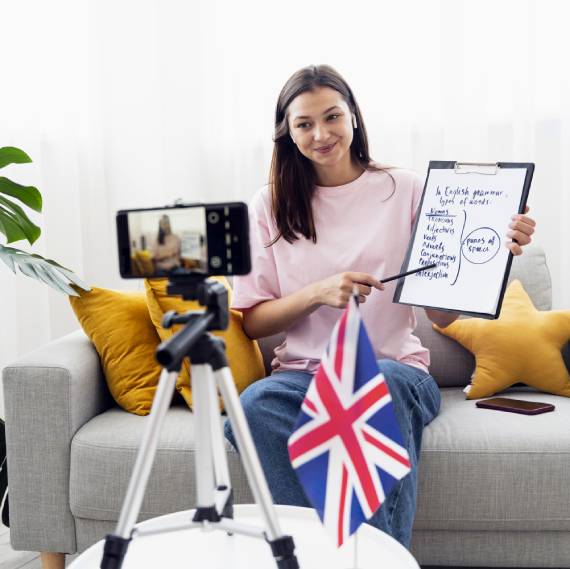Last Updated on March 17, 2024

Whether you’re a small business owner or a student building your online marketing toolkit, understanding accessibility and SEO is a powerful move.
These two concepts might seem separate, but they must work together – only then is your website discoverable by everyone and usable by all.
Mastering both will help you more effectively market your small business. If you are a student, they will give you a competitive edge as you enter the workplace.
- Accessibility and SEO: Understanding the Dynamic Duo
- Accessibility and SEO: A Focus for Online Marketing Students
- Accessibility and SEO: A Focus for Small Business Owners
Accessibility and SEO: Understanding the Dynamic Duo
Accessibility means Barrier-free
Imagine a well-crafted social media campaign driving traffic to a website with a broken “Buy Now” button. Picture if you will, a website layout that’s impossible to navigate with a screen reader. Crazy, right?
An accessible website is more than a mobile-friendly website. Accessibility ensures your website is usable for everyone, regardless of ability. This includes users with visual impairments, hearing difficulties, motor limitations, cognitive differences, and more. (Read more about the importance of accessibility in your marketing.)
Search Engine Optimization (SEO)
Does everyone know you? If they don’t, they can’t shop at your store, or hire you to work for them. SEO can help. Think of SEO as a flag that helps get you noticed by search engines.
By optimizing your website’s content and structure, you increase its chances of ranking higher in search results, making it easier for potential customers to find your business. (Read more about SEO.)
Benefits for Everyone
Here’s why both accessibility and SEO are essential for anyone interested in online marketing success:
For Small Businesses:
- Reach a Wider Audience: Millions of people with disabilities use the internet. By making your website accessible, you tap into a vast potential customer base.
- Boost SEO: Search engines increasingly favour accessible websites. Accessible features like clear language and image descriptions (alt text) can also improve SEO!
- Enhanced User Experience: Accessibility benefits everyone, not just users with disabilities. A well-structured, easy-to-navigate website creates a positive visitor experience, leading to higher engagement and conversions.
For Students:
- Stand Out from the Crowd: The ability to offer both accessibility and SEO services is a valuable asset in the competitive online marketing job market.
- Future-Proof Your Skills: Accessibility is becoming increasingly important, with legislation and consumer trends favouring inclusive websites. SEO is constantly evolving, but the core principles remain valuable.
- Ethical Marketing: Accessibility allows you to reach a wider audience and ensures everyone has an equal opportunity to engage with your client’s website.
Learning Accessibility and SEO: Your Roadmap
Here are some resources to kickstart your learning journey:
- Accessibility: The W3C Web Accessibility Initiative (WAI) offers many free resources and training materials (https://www.w3.org/WAI/).
- SEO: Moz Beginner’s Guide to SEO is a fantastic starting point (https://moz.com/beginners-guide-to-seo/quick-start-guide). Many online courses and tutorials are also available.
The Synergy Between Accessibility and SEO
The beauty of these two concepts is that they often go hand-in-hand. Many SEO practices inherently improve accessibility, and vice versa. Here’s how:
- Clear & Concise Language: This benefits search engines (easier to understand content) and users with reading difficulties.
- Descriptive Alt Text: This helps search engines understand your images and makes them accessible to visually impaired users.
- Semantic Markup: This code helps search engines understand your website’s structure, aiding SEO and screen reader navigation for visual-impaired users.
By mastering both accessibility and SEO, you’ll be well-equipped to create websites that are not only discoverable but also inclusive and user-friendly for everyone.
Accessibility and SEO: A Powerful Duo for Your Online Marketing Skillset

Are you a student looking to expand your online marketing toolkit? Look no further than the potent combination of accessibility and SEO!
While these terms might seem separate, they work in beautiful harmony to create a website that’s not only discoverable but also usable by everyone. Mastering these skills will make you a more well-rounded online marketing professional.
Understanding the Powerhouse Duo
- Website Accessibility: Imagine a well-crafted social media campaign driving traffic to a website with a broken “Buy Now” button or a layout that’s impossible to navigate with a screen reader. Accessibility ensures your website is usable for everyone, regardless of ability. This includes users with visual impairments, hearing difficulties, motor limitations, cognitive differences, and more.
- Search Engine Optimization (SEO): Think of SEO as the secret sauce that gets your website noticed by search engines. By optimizing your website’s content and structure, you increase its chances of ranking higher in search results, making it easier for potential customers to find your client’s business (or your own venture in the future!).
Why Accessibility and SEO are Hot Skills for Students
Here’s why learning about both accessibility and SEO is a smart move for any aspiring online marketing whiz:
- Stand Out from the Crowd: The ability to offer accessibility and SEO services is a valuable asset in the competitive online marketing job market.
- Future-Proof Your Skills: Accessibility is becoming increasingly important, with legislation and consumer trends favouring inclusive websites. SEO is constantly evolving, but the core principles remain valuable.
- Ethical Marketing: Accessibility allows you to reach a wider audience and ensures everyone has an equal opportunity to engage with your client’s website.
What is the difference between accessibility and usability? At the centre of accessibility is the goal of making the right content accessible. Usability means the quality, satisfaction, and efficiency a person experiences when using your website.
https://warrenlainenaida.net/making-your-website-accessible-for-everyone/
Learning Accessibility and SEO: A Student’s Roadmap
Here are some resources to kickstart your learning journey:
- Accessibility: The W3C Web Accessibility Initiative (WAI) offers many free resources and training materials (https://www.w3.org/WAI/).
- SEO: Moz Beginner’s Guide to SEO is a fantastic starting point (https://moz.com/beginners-guide-to-seo/quick-start-guide). Many online courses and tutorials are also available.
Search Engine Optimization (SEO) takes a website built by humans and makes it easily understandable to search engine robots. If you offer the solution to someone’s problem, but they have not heard of you, SEO gets your name in front of them. That’s it!
https://warrenlainenaida.net/seo-online-learn-search-engine-optimisation/
The Synergy Between Accessibility and SEO
The beauty of these two concepts is that they often go hand-in-hand. Many SEO practices inherently improve accessibility, and vice versa. Here’s how:
- Clear & Concise Language: This benefits search engines (easier to understand content) and users with reading difficulties.
- Descriptive Alt Text: This helps search engines understand your images and makes them accessible to visually impaired users.
- Semantic Markup: This code helps search engines understand your website’s structure, aiding SEO and screen reader navigation for visual-impaired users.
By mastering both accessibility and SEO, you’ll be well-equipped to create websites that are not only discoverable but also inclusive and user-friendly for everyone.
Accessibility and SEO: A Powerful Duo for Your Small Business Website

In today’s digital landscape, having a website is crucial for any small business. But simply having a website isn’t enough. To truly thrive online, you need a website that’s both accessible and SEO-friendly.
This article will explain these two concepts and show you how they work together to benefit your small business.
Understanding Accessibility and SEO
- Website Accessibility: Imagine a storefront with a locked door or a ramp leading nowhere. That’s what an inaccessible website feels like for people with disabilities. Accessibility ensures your website is usable by everyone, regardless of ability. This includes users with visual impairments, hearing difficulties, motor limitations, cognitive differences, and more.
- Search Engine Optimization (SEO): Think of SEO as the key to unlocking the door to your website. It’s the process of optimizing your website to rank higher in search engine results, making it easier for potential customers to find you online.
Why Accessibility Matters for Small Businesses
Here’s why accessibility is more than just “the right thing to do” for your small business:
- Reach a Wider Audience: Millions of people with disabilities use the internet. By making your website accessible, you tap into this vast potential customer base.
- Boost SEO: Search engines like Google increasingly favour accessible websites. Accessible features like clear language and image descriptions (alt text) can also improve SEO!
- Enhanced User Experience: Accessibility benefits everyone, not just users with disabilities. A well-structured, easy-to-navigate website creates a positive visitor experience, leading to higher engagement and conversions.
Accessible web design is very simple to understand. An accessible website is accessible to all users and all devices without restrictions.
https://warrenlainenaida.net/making-your-website-accessible-for-everyone/
SEO for Small Businesses: A Quick Start
Here are some basic SEO practices for small businesses:
- Keyword Research: Identify terms your target audience uses to search for products or services like yours.
- Content Creation: Create high-quality, informative content relevant to your target audience and those keywords.
- Mobile-Friendly Design: Ensure your website displays well on all devices, especially mobile phones.
Successful SEO involves a combination of technical and creative strategies aimed at improving the visibility of your brand, and the quantity and quality of traffic to your website. SEO helps get you in front of people.
https://warrenlainenaida.net/hungry-for-some-seo-tips-heres-an-seo-appetizer-for-your-business/
Accessibility and SEO: Working Together
The beauty of accessibility and SEO is their synergy. Many SEO practices inherently improve accessibility, and vice versa. Here’s how:
- Clear & Concise Language: This benefits search engines (easier to understand content) and users with reading difficulties.
- Descriptive Alt Text: This helps search engines understand your images and makes them accessible to visually impaired users.
- Semantic Markup: This code helps search engines understand your website’s structure, aiding SEO and screen reader navigation for visual-impaired users.
Making Accessibility and SEO a Priority
There are many online resources and tools to help you improve your website’s accessibility and SEO. Additionally, consider consulting a web developer specializing in accessibility to ensure your website meets best practices.
By prioritizing accessibility and SEO, you’re creating a website that’s inclusive, user-friendly, and more likely to attract new customers. Remember, a successful website isn’t just about aesthetics; it’s about opening your doors to everyone and making it easy for them to find you online.
Thanks for the main article image used here to Emma Dau https://unsplash.com/@daugirl